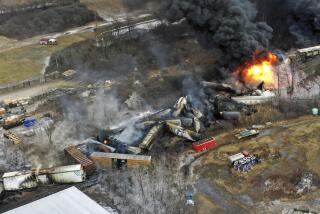Last Chance for Amtrak
Amtrak, right now, is the little engine that couldn’t. Last year it lost $1.1 billion. This year it has laid off hundreds of mechanics and station agents, with the result that a worried Federal Railroad Administration put it on a special safety watch.
The arrival last week of David L. Gunn--known for turning around troubled transportation systems in New York, Philadelphia and other cities--as the new president of Amtrak offers a last chance to salvage passenger rail in America.
Sept. 11 showed that Amtrak serves an important purpose. Nationwide, it runs 265 trains each weekday, and its daily passenger traffic between New York and Washington replaces more than 100 airplane flights. But Amtrak’s woes include insufficient capital, low employee morale, crumbling equipment and $3 billion in debt. The recession and increased security costs added to revenue shortfalls this year. The Bush administration has budgeted $521 million for Amtrak in 2003, but Amtrak says it needs $2.5 billion, an imposing gap.
The source of the problem is Congress’ decree in 1997 that Amtrak become self-supporting by the end of 2002. The demand reeks of a double standard. Amtrak’s $30 billion in federal subsidies over 30 years is not small change, but it pales in comparison with $1.89 trillion in air travel and highway subsidies. Previous Amtrak President George D. Warrington foolishly tried to reach self-sufficiency by cutting maintenance of equipment and roadbeds. In February, he announced that Amtrak this year would slash $285 million in expenses and capital improvements. Such cutbacks have gutted Amtrak’s ability to provide even minimally reliable service.
Congress has not only underfunded Amtrak but also demanded that it retain its most unprofitable long-distance lines. The only profitable routes are in the Northeast corridor; almost all others lose money. Routes in California and the Pacific Northwest receive state subsidies that help make up the gap. The rest, such as the Empire Builder from Chicago to Seattle, lose about $100 a ticket.
In February, a hostile federal commission, the Amtrak Reform Council, called for privatizing routes, which ultimately would kill passenger rail. Sen. Ernest F. Hollings (D-S.C.) countered with proposed legislation that would give Amtrak $4.6 billion over the next five years to renovate track and create high-speed corridors. Hollings’ subsidy would be for naught, however, if Amtrak did not put its fiscal house in order. That includes a critical look at top-heavy management.
The no-nonsense Gunn rejects privatization or slashing routes to the point that Amtrak is no longer a public service. He says he intends to make executives show that they are actually working. He also should develop a detailed business plan that breaks down expenses, revenue and ridership. Amtrak removes traffic from congested roads and air corridors and deserves some subsidy. Not, however, a free ride.
More to Read
Sign up for Essential California
The most important California stories and recommendations in your inbox every morning.
You may occasionally receive promotional content from the Los Angeles Times.










